List of birds


This article lists living orders and families of birds. The links below should then lead to family accounts and hence to individual species.
The passerines (perching birds) alone account for well over 5,000 species. In total there are about 10,000 species of birds described worldwide, though one estimate of the real number places it at almost twice that.[1]
Taxonomy is very fluid in the age of DNA analysis, so comments are made where appropriate, and all numbers are approximate. In particular see Sibley-Ahlquist taxonomy for a very different classification.
Phylogeny
[edit]Cladogram of modern bird relationships based on Jarvis, E.D. et al. (2014)[2] with some clade names after Yuri, T. et al. (2013).[3]
Subclass Palaeognathae
[edit]The Palaeognathae or "old jaws" is one of the two superorders recognized within the taxonomic class Aves and consist of the ratites and tinamous. The ratites are mostly large and long-legged, flightless birds, lacking a keeled sternum. Traditionally, all the ratites were place in the order Struthioniformes. However, recent genetic analysis has found that the group is not monophyletic, as it is paraphyletic with respect to the tinamous, so the ostriches are classified as the only members of the order Struthioniformes and other ratites placed in other orders.[6][7]
Order Struthioniformes
[edit]

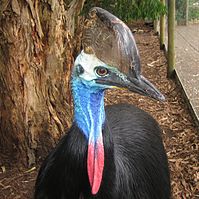
Africa; 2 species
- Family Struthionidae: ostrich
Infraclass Notopalaeognathae
[edit]Order Rheiformes
[edit]South America; 2 species
- Family †Opisthodactylidae
- Family Rheidae: rheas
Order Casuariiformes
[edit]Australasia; 4 species
- Family Casuariidae: cassowaries and emu
Order Apterygiformes
[edit]Australasia; 5 species
- Family Apterygidae: kiwis
Order †Aepyornithiformes
[edit]Madagascar
- Family Aepyornithidae: elephant birds
Order †Dinornithiformes
[edit]New Zealand
- Family Megalapteryidae: upland moas
- Family Dinornithidae: great moas
- Family Emeidae: lesser moas
Order Tinamiformes
[edit]South America; 45 species
- Family Tinamidae: tinamous
Subclass Neognathae
[edit]Nearly all living birds belong to the subclass Neognathae or "new jaws". With their keeled sternum (breastbone), unlike the ratites, they are known as carinatae.
Infraclass Galloanserae
[edit]Order Galliformes
[edit]
Worldwide; 250 species
- Family †Sylviornithidae
- Suborder Megapodii
- Family Megapodidae: megapodes
- Suborder Craci
- Family Cracidae: chachalacas, curassows, and guans
- Suborder Phasiani
- Superfamily Numidioidea
- Family Numididae: guineafowl
- Superfamily Phasianoidea: pheasants and allies
- Family Odontophoridae: New World quail
- Family Phasianidae: pheasants and relatives
- Superfamily Numidioidea
Order †Gastornithiformes
[edit]- Family Gastornithidae (see Gastornis)
- Family Dromornithidae: mihirungs
Order Anseriformes
[edit]Worldwide; 150 species
- Family Anhimidae: screamers
- Family Anseranatidae: magpie-goose
- Family Anatidae: ducks, geese, and swans
Superorder Mirandornithes
[edit]Order Podicipediformes
[edit]Worldwide; 19 species
- Family Podicipedidae: grebes
Order Phoenicopteriformes
[edit]Worldwide; 6 species
- Family †Palaelodidae: swimming flamingos
- Family Phoenicopteridae: flamingos
Superorder Columbimorphae
[edit]Order Columbiformes
[edit]Worldwide; 300 species
- Family Columbidae: pigeons and doves
Order Pterocliformes
[edit]Africa, Europe, Asia; 16 species
- Family Pteroclidae: sandgrouse
Order Mesitornithiformes
[edit]Madagascar; 3 species
- Family Mesitornithidae: mesites
Grandorder Cypselomorphae
[edit]Order Caprimulgiformes
[edit]Worldwide; 97 species
- Caprimulgidae: nightjars
Order Steatornithiformes
[edit]South America; 1 species
- Family Steatornithidae: oilbird
Order Nyctibiiformes
[edit]Americas; 7 species
- Family Nyctibiidae: potoos
Order Podargiformes
[edit]
Asia and Australasia; 14 species
- Family Podargidae: frogmouths
Order Aegotheliformes
[edit]Australasia; 10 species
- Family Aegothelidae: owlet-nightjars
Order Apodiformes
[edit]Worldwide; 478 species
- Family Hemiprocnidae: treeswifts
- Family Apodidae: swifts
- Family Trochilidae: hummingbirds
Grandorder Otidimorphae
[edit]Order Cuculiformes
[edit]Worldwide; 150 species
- Family Cuculidae: cuckoos and relatives
Order Musophagiformes
[edit]Africa; 23 species
- Family Musophagidae: turacos and relatives
Order Otidiformes
[edit]Africa and Eurasia; 27 species
- Family Otididae: bustards
Order Opisthocomiformes
[edit]South America; 1 species
- Family Opisthocomidae: hoatzin
Order Gruiformes
[edit]Worldwide; 164 species
- Suborder Grui: cranes and allies
- Family Gruidae: cranes
- Family Aramidae: limpkin
- Family Psophiidae: trumpeters
- Suborder Ralli: rails and allies
- Family †Aptornithidae: adzebills
- Family Heliornithidae: finfoots
- Family Sarothruridae: flufftails
- Family Rallidae: rails and relatives
Order Charadriiformes
[edit]Worldwide; 350 species
- Suborder Charadrii
- Infraorder Chionida: thick-knees and allies
- Family Burhinidae: thick-knees and relatives
- Family Chionididae: sheathbills
- Family Pluvianellidae: Magellanic plover
- Infraorder Charadriida: plover-like waders
- Family Pluvialidae: golden plovers
- Family Ibidorhynchidae: ibisbill
- Family Haematopodidae: oystercatchers
- Family Recurvirostridae: avocets and stilts
- Family Charadriidae: plovers and lapwings
- Infraorder Chionida: thick-knees and allies
- Suborder Scolopaci
- Infraorder Jacanida: jacana-like waders
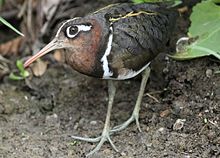
Greater painted-snipe 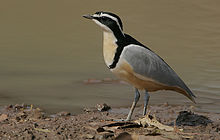
Egyptian plover - Family Jacanidae: jacanas
- Family Thinocoridae: seedsnipes
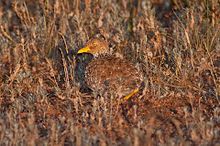
Plains-wanderer
- Infraorder Scolopacida
- Family Scolopacidae: sandpipers and relatives
- Infraorder Jacanida: jacana-like waders
- Suborder Lari
- Infraorder Turnicida
- Family Turnicidae: buttonquail
- Infraorder Larida: gulls and allies
- Family Glareolidae: coursers and pratincoles
- Family Dromadidae: crab-plover
- Family Stercorariidae: skuas and jaegers
- Family Alcidae: auks and puffins
- Family Laridae: gulls, skimmers and terns
- Infraorder Turnicida
Grandorder Phaethontimorphae
[edit]Order Eurypygiformes
[edit]Neotropics and New Caledonia; 2 species
- Family Rhynochetidae: kagu
Sunbittern
Order Phaethontiformes
[edit]Oceanic; 3 species
- Family Phaethontidae: tropicbirds
Grandorder Aequornithes
[edit]Order Gaviiformes
[edit]North America, Eurasia; 5 species
- Family Gaviidae: loons
Order Sphenisciformes
[edit]Antarctic and southern waters; 17 species
- Family Spheniscidae: penguins
Order Procellariiformes
[edit]Pan-oceanic; 120 species
- Family Diomedeidae: albatrosses
- Family Oceanitidae: austral storm petrels
- Family Hydrobatidae: northern storm petrels
- Family Procellariidae: petrels and relatives
Order Ciconiiformes
[edit]Worldwide; 19 species

- Family Ciconiidae: storks
Order Suliformes
[edit]Worldwide; 59 species
- Suborder Fregatae
- Family Fregatidae: frigatebirds
- Suborder Sulae
- Family Sulidae: boobies and gannets
- Family Anhingidae: darters
- Family Phalacrocoracidae: cormorants and shags
Order Pelecaniformes
[edit]
Worldwide; 108 species
- Suborder Threskiornithes
- Family Threskiornithidae: ibises and spoonbills
- Suborder Pelecani
- Family Scopidae: hamerkop
- Family Balaenicipitidae: shoebill
- Family Pelecanidae: pelicans
- Suborder Ardeae
- Family Ardeidae: herons and relatives
Order Accipitriformes
[edit]
Worldwide; 260 species
- Suborder Cathartae
- Family Cathartidae: New World vultures
- Suborder Accipitres
- Family Sagittariidae: secretarybird
- Family Pandionidae: osprey
- Family Accipitridae: hawks, eagles, buzzards, harriers, kites and Old World vultures
Order Strigiformes
[edit]Worldwide; 250 species
Order Coliiformes
[edit]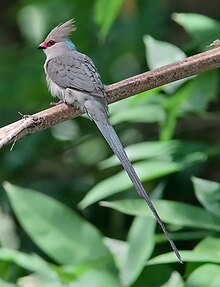
Sub-Saharan Africa; 6 species
- Family Coliidae: mousebirds
Order Leptosomiformes
[edit]Madagascar; 1 species
- Family Leptosomidae: cuckoo-roller
Order Trogoniformes
[edit]Sub-Saharan Africa, Americas, Asia; 35 species
- Family Trogonidae: trogons and quetzals
Order Bucerotiformes
[edit]Old World, New Guinea; 64 species
- Superfamily Buceroidea
- Family Bucerotidae: hornbills
- Superfamily Upupoidea
- Family Upupidae: hoopoe
- Family Phoeniculidae: woodhoopoes
Order Coraciiformes
[edit]Worldwide; 144 species
- Suborder Meropi
- Family Meropidae: bee-eaters
- Suborder Coracii
- Family Coraciidae: rollers
- Family Brachypteraciidae: ground rollers
- Suborder Alcedines
- Family Todidae: todies
- Family Momotidae: motmots
- Family Alcedinidae: kingfishers

Order Piciformes
[edit]Worldwide except Australasia; 400 species
- Suborder Galbuli
- Family Galbulidae: jacamars
- Family Bucconidae: puffbirds
- Suborder Pici
- Family Lybiidae: African barbets
- Family Megalaimidae: Asian barbets
- Family Ramphastidae: toucans
- Family Semnornithidae: toucan barbets
- Family Capitonidae: American barbets
- Family Picidae: woodpeckers
- Family Indicatoridae: honeyguides
Grandorder Australaves
[edit]Order Cariamiformes
[edit]South America; 2 species
- Family Cariamidae: seriemas
Order Falconiformes
[edit]Worldwide; 60 species
- Family Falconidae: falcons and relatives
Order Psittaciformes
[edit]Pan-tropical, southern temperate zones; 330 species
- Superfamily Strigopoidea
- Family Strigopidae: kakapo
- Family Nestoridae: kea and kakas
- Superfamily Cacatuoidea
- Family Cacatuidae: cockatoos and cockatiel
- Superfamily Psittacoidea
- Family Psittacidae: African and American parrots
- Family Psittaculidae: Australasian parrots
- Family Psittrichasiidae: Pesquet's parrot, vasa parrots
Order Passeriformes
[edit]
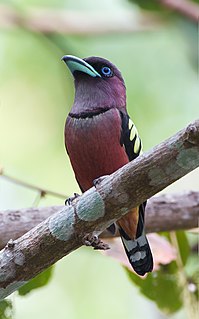


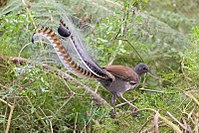
Worldwide; 6,500 species
- Suborder Acanthisitti
- Family Acanthisittidae: New Zealand wrens
- Suborder Tyranni: suboscines
- Infraorder Eurylaimides: Old World suboscines
- Family Sapayoidae: sapayoa
- Family Calyptomenidae: Calyptomenid broadbills
- Family Pittidae: pittas
- Family Eurylaimidae: broadbills
- Family Philepittidae: asities
- Infraorder Tyrannides: New World suboscines
- Parvorder Tyrannida: bronchophones
- Family Pipridae: manakins
- Family Cotingidae: cotingas
- Family Oxyruncidae: sharpbills
- Family Onychorhynchidae: royal flycatchers and allies
- Family Tityridae: becards and tityras
- Family Pipritidae: pipriteses
- Family Platyrinchidae: spadebills
- Family Tachurididae: many-colored rush tyrants
- Family Rhynchocyclidae: mionectine flycatchers
- Family Tyrannidae: tyrant flycatchers
- Parvorder Furnariida: tracheophones
- Family Melanopareiidae: crescent-chests
- Family Conopophagidae: gnateaters
- Family Thamnophilidae: antbirds
- Family Grallariidae: antpittas
- Family Rhinocryptidae tapaculos
- Family Formicariidae: ground antbirds
- Family Furnariidae: ovenbirds
- Parvorder Tyrannida: bronchophones
- Infraorder Eurylaimides: Old World suboscines
- Suborder Passeri: oscines
- Infraorder Menurides
- Family Atrichornithidae: scrub-birds
- Family Menuridae: lyrebirds
- Infraorder Climacterides
- Family Ptilonorhynchidae: bowerbirds
- Family Climacteridae: Australasian treecreepers
- Infraorder Meliphagides
- Family Maluridae: Australasian wrens
- Family Dasyornithidae: bristlebirds
- Family Pardalotidae: pardalotes
- Family Acanthizidae: gerygones, thornbills and allies
- Family Meliphagidae: honeyeaters and relatives
- Infraorder Orthonychides
- Family Pomatostomidae: Australasian babblers
- Family Orthonychidae: logrunners
- Infraorder Corvides
- Superfamily Cinclosomatoidea
- Family Cinclosomatidae: quail-thrushes and jewel-babblers
- Superfamily Campephagoidea
- Family Campephagidae: cuckoo-shrikes
- Superfamily Mohouoidea
- Family Mohouidae: whitehead and allies
- Superfamily Neosittoidea
- Family Neosittidae: sittellas
- Superfamily Orioloidea
- Family Eulacestomidae: wattled ploughbills
- Family Psophodidae: whipbirds and quail-thrushes
- Family Oreoicidae: Australo-Papuan bellbirds
- Family Falcunculidae: crested shriketits
- Family Paramythiidae: painted berrypeckers
- Family Pteruthiidae: shrike-babblers
- Family Vireonidae: vireos and relatives
- Family Pachycephalidae: whistlers and relatives (Colluricinclidae)
- Family Oriolidae: Old World orioles
- Superfamily Malaconotoidea
- Family Machaerirhynchidae: boatbills
- Family Artamidae: woodswallows and butcherbirds
- Family Rhagologidae: mottled berryhunter
- Family Aegithinidae: ioras
- Family Pityriaseidae: bristlehead
- Family Malaconotidae: bushshrikes and relatives
- Family Platysteiridae: wattle-eyes and batises
- Family Vangidae: vangas (Tephrodornithidae; Prionopidae)
- Superfamily Corvoidea
- Family Rhipiduridae: fantails
- Family Lamproliidae: silktail, drongo fantail
- Family Dicruridae: drongos
- Family Ifritidae: blue-capped ifrits
- Family Melampittidae: melampittas
- Family Corcoracidae: Australian mudnesters
- Family Paradisaeidae: birds-of-paradise
- Family Monarchidae: monarch flycatchers
- Family Laniidae: shrikes
- Family Corvidae: jays and crows
- Superfamily Cinclosomatoidea
- Infraorder Passerides
- Parvorder Melanocharitida
- Family Melanocharitidae: berrypeckers
- Parvorder Cnemophilida
- Family Cnemophilidae: satinbirds
- Parvorder Petroicida
- Family Petroicidae: Australasian robins
- Family Notiomystidae: stitchbird
- Family Callaeidae: wattlebirds
- Parvorder Eupetida
- Family Picathartidae: rockfowl
- Familt Chaetopidae: rock-jumpers
- Family Eupetidae: rail-babbler
- Parvorder Sylviida
- Superfamily Paroidea
- Family Stenostiridae: fairy warblers
- Family Hyliotidae: hyliotas
- Family Remizidae: penduline tits
- Family Paridae: chickadees and true tits
- Superfamily Alaudoidea
- Family Nicatoridae: nicators
- Family Panuridae: bearded reedling
- Family Alaudidae: larks
- Family Macrosphenidae: African warblers
- Superfamily Locustelloidea
- Family Cisticolidae: cisticolas and relatives
- Family Acrocephalidae: marsh warblers
- Family Pnoepygidae: pygmy wren-babblers
- Family Locustellidae: grass warblers
- Family Donacobiidae: donacobius
- Family Bernieridae: Malagasy warblers
- Family Hirundinidae: swallows and martins
- Family Pycnonotidae: bulbuls
- Superfamily Aegithaloidea
- Family Phylloscopidae: leaf warblers
- Family Cettiidae: bush warblers (Erythrocercidae; Scotocercidae)
- Family Hyliidae: hylias
- Family Aegithalidae: bushtits
- Superfamily Sylvioidea
- Family Sylviidae: true warblers
- Family Paradoxornithidae: parrotbills, fulvettas
- Family Zosteropidae: white-eyes
- Family Timaliidae: babblers and relatives
- Family Pellorneidae: fulvettas, ground babblers
- Family Leiothrichidae: laughing thrushes
- Superfamily Paroidea
- Parvorder Muscicapida
- Superorder Reguloidea
- Family Regulidae: kinglets
- Superfamily Bombycilloidea
- Family Elachuridae: spotted wren-babblers
- Family †Mohoidae: Hawaiian honeyeaters
- Family Ptiliogonatidae: silky-flycatchers
- Family Bombycillidae: waxwings
- Family Dulidae: palmchat
- Family Hypocoliidae: hypocolius
- Family Hylocitreidae: hylocitrea
- Superfamily Certhioidea
- Family Tichodromidae: wallcreeper
- Family Sittidae: nuthatches
- Family Certhiidae: treecreepers
- Family Troglodytidae: wrens
- Family Polioptilidae: gnatcatchers
- Superfamily Muscicapoidea
- Family Cinclidae: dippers
- Family Turdidae: thrushes and relatives
- Family Muscicapidae: flycatchers and relatives
- Family Buphagidae: oxpeckers
- Family Mimidae: mockingbirds and thrashers
- Family Sturnidae: starlings and mynas (Rhabdornithidae)
- Superorder Reguloidea
- Parvorder Passerida
- Family Promeropidae: sugarbirds
- Family Arcanatoridae: dapplethroat and allies
- Family Dicaeidae: flowerpeckers
- Family Nectariniidae: sunbirds
- Family Irenidae: fairy-bluebirds
- Family Chloropseidae: leafbirds
- Family Peucedramidae: olive warbler
- Family Prunellidae: accentors
- Superfamily Ploceoidea
- Family Urocynchramidae: pink-tailed bunting
- Family Ploceidae: weavers and relatives
- Family Viduidae: whydahs and indigobirds
- Family Estrildidae: weaver finches
- Superfamily Passeroidea
- Family Passeridae: Old World sparrows
- Family Motacillidae: wagtails and pipits
- Family Fringillidae: finches and relatives
- Family Calcariidae: longspurs, snow buntings
- Family Rhodinocichlidae: rosy thrush-tanagers
- Family Emberizidae: Old World buntings
- Family Passerellidae: American sparrows
- Family Phaenicophilidae: palm-tanager and allies
- Family Icteridae: New World blackbirds and New World orioles
- Family Teretistridae: Cuban warblers
- Family Parulidae: wood warblers
- Family Mitrospingidae
- Family Cardinalidae: cardinals, grosbeaks, and New World buntings
- Family Thraupidae: tanagers and relatives (Coerebidae)
- Parvorder Melanocharitida
- Infraorder Menurides
See also
[edit]- Lists of animals
- List of bird genera
- List of chicken breeds
- List of birds by common name
- List of individual birds
- Lists by continent
- Lists by smaller geographic unit
- Extinct birds
- List of fictional birds
References
[edit]- ^ Barrowclough, GF; Cracraft, J; Klicka, J; Zink, RM (2016). "How Many Kinds of Birds Are There and Why Does It Matter?". PLOS ONE. 11 (11): e0166307. Bibcode:2016PLoSO..1166307B. doi:10.1371/journal.pone.0166307. PMC 5120813. PMID 27880775.
- ^ Jarvis, E.D.; et al. (2014). "Whole-genome analyses resolve early branches in the tree of life of modern birds". Science. 346 (6215): 1320–1331. Bibcode:2014Sci...346.1320J. doi:10.1126/science.1253451. PMC 4405904. PMID 25504713.
- ^ Yuri, T.; et al. (2013). "Parsimony and Model-Based Analyses of Indels in Avian Nuclear Genes Reveal Congruent and Incongruent Phylogenetic Signals". Biology. 2 (1): 419–444. doi:10.3390/biology2010419. PMC 4009869. PMID 24832669.
- ^ Boyd, John (2007). "NEORNITHES: 46 Orders" (PDF). John Boyd's website. Retrieved 30 December 2017.[unreliable source?]
- ^ Worthy, T.H.; Degrange, F.J.; Handley, W.D.; Lee, M.S.Y. (2017). "The evolution of giant flightless birds and novel phylogenetic relationships for extinct fowl (Aves, Galloanseres)". Royal Society Open Science. 11 (10): 170975. Bibcode:2017RSOS....470975W. doi:10.1098/rsos.170975. PMC 5666277. PMID 29134094.
- ^ Hackett, S.J.; et al. (2008). "A Phylogenomic Study of Birds Reveals Their Evolutionary History". Science. 320 (5884): 1763–1768. Bibcode:2008Sci...320.1763H. doi:10.1126/science.1157704. PMID 18583609. S2CID 6472805.
- ^ Yuri, T (2013). "Parsimony and model-based analyses of indels in avian nuclear genes reveal congruent and incongruent phylogenetic signals". Biology. 2 (1): 419–44. doi:10.3390/biology2010419. PMC 4009869. PMID 24832669.




